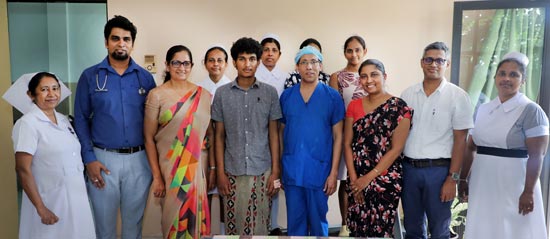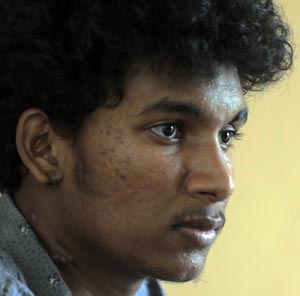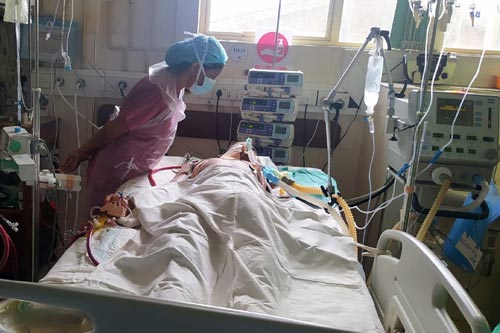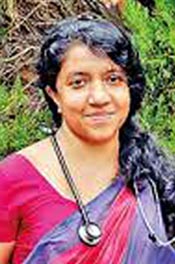A young life saved by ECMO

Some members of the multidisciplinary team who attended on Shahid
Eighteen-year-old Mohamed Shahid is back home from hospital – not as a victim of drowning but as a youth with a long life ahead of him.
It was touch-and-go for Shahid but he was at the right place at the right time to be pulled back from the jaws of death and be given a brand new lease of life.
The right place was the Karapitiya Teaching Hospital within which functions the life-saving procedure of ECMO (Extracorporeal membrane oxygenation) with a multidisciplinary trained, skilled and passionate staff.
“If Shahid was brought just two hours later, he would be no more,” says the ECMO team led by Consultant Cardiothoracic Surgeon Dr. Tolusha Harischandra and Consultant Paediatrician Dr. Kapilani Withanaarachchi.
 Transferred early morn on a Sunday to Karapitiya by desperate doctors at the Colombo South Teaching Hospital, Kalubowila, who were battling to save Shahid’s life, Dr. Harischandra had thrown sleep to the winds and arrived to save this young life.
Transferred early morn on a Sunday to Karapitiya by desperate doctors at the Colombo South Teaching Hospital, Kalubowila, who were battling to save Shahid’s life, Dr. Harischandra had thrown sleep to the winds and arrived to save this young life.
This was while, a strong supporter whose invaluable efforts helped start ECMO at Karapitiya, Dr. Richard Firmin from the United Kingdom, had also been by Shahid’s bedside that morning. He had been at Karapitiya to hold an ECMO workshop and demonstrate how the new state-of-the-art machine works.
It is Shahid’s father, Mohamed Haniffa, who explains how his son had ended up at Karapitiya. A joyous occasion, a wedding, had brought his immediate family (wife, son Shahid and younger daughter) as well as extended family to Colombo from Nuwara Eliya where they live at Shanthipura. They arrived on July 6 and attended the wedding on July 9.

Dr. Tolusha Harischandra checking on Shahid (inset) Dr. Harischandra
On the morning of July 11, the whole lot went to Galkissa (Mount Lavinia), muhuda balanna (to see the sea), says Haniffa. Yes, the sea was rough and there were red flags along the beach but not at the spot where they were. Shahid and his 16-year-old cousin sat on the beach where the waves were lapping the sand, to have a sea-bath, when suddenly they were carried away.
“Our frantic cries sent three Lifeguards after them,” says Haniffa, thankful for their prompt action.
The two youth were brought back to shore amidst the shock and wails of the family. Shahid was lifeless but his cousin was alright. The Lifeguards had immediately performed cardiopulmonary resuscitation (CPR) and Shahid had coughed up the sea water he had swallowed and begun breathing. Suwa Seriya (the 1990 ambulance service) too had arrived speedily and taken Shahid to the Kalubowila Hospital’s Intensive Care Unit (ICU).
“Mathakayak ne,” says Shahid shyly, explaining that he does not have any memory of the episode.
Dr. Withanaarachchi talks of how the Kalubowila doctors had immediately put him on the ventilator and battled very hard to save his life for four days. There was, however, so much the ventilator could do.
Getting in touch with Karapitiya’s ECMO team, the Kalubowila doctors had then transferred him on the night of July 15 (Saturday) to Karapitiya.
 “When he was brought in, Shahid’s blood oxygen level [oxygen (O2) saturation – the amount of oxygen that's circulating in the blood] was 75% when it should be 95-100%,” says Dr. Withanaarachchi, reiterating that when ventilation fails, ECMO is the one and only option.
“When he was brought in, Shahid’s blood oxygen level [oxygen (O2) saturation – the amount of oxygen that's circulating in the blood] was 75% when it should be 95-100%,” says Dr. Withanaarachchi, reiterating that when ventilation fails, ECMO is the one and only option.
The Sunday Times learns that soon after they did the cannulation and established ECMO, Shahid’s saturation picked up to 96%.
For the uninitiated, Dr. Harischandra explains the procedure – a draining cannula being positioned in the inferior vena cava at the level of the liver, to enable the blood, heavy with CO2 but having less O2, to be sent through the machine. The machine then removed the high levels of CO2, oxygenated the blood and pumped the blood back to the right atrium of Shahid’s heart through a cannula inserted in the neck vein.
Under ECMO, a pump is used to circulate blood through an artificial lung to take out CO2, get O2 levels up and send the blood back into the bloodstream, providing heart-lung bypass support outside the body.
Dr. Harischandra points out that ECMO did what the lungs usually do – remove all excess CO2 from Shahid’s body and restore the O2, thus keeping all organs alive. It also allowed the damaged lungs to rest and recover.
While ECMO was doing what it was meant to do, medicines had been administered to Shahid to curb infections ravaging his body, making a fever spike very high.
The multidisciplinary groups which had laboured to save Shahid included the ECMO team led by Dr. Harischandra; the perfusionist & perfusion assistant; the ICU team led by Consultant Anaesthetist Dr Keshari De Silva; the surgical team led by Consultant Surgeon Dr. Nalitha Wijesundara; the medical team led by Consultant Physician Dr. Wimalasiri Uluwattage; the laboratory team led by Consultant Microbiologist Dr. Bhagya Piyasiri; and the radiology and Blood Bank teams.
All these teams had been heavily supported by Consultants, junior doctors, nursing officers and healthcare assistants.
Searching for an ideal partner? Find your soul mate on Hitad.lk, Sri Lanka's favourite marriage proposals page. With Hitad.lk matrimonial advertisements you have access to thousands of ads from potential suitors who are looking for someone just like you.


